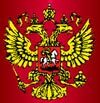| Ambassador Diplomatic List Russia-Ireland Consular Division Trade Mission Cultural Centre |
| COUNTRY PROFILE |
| President Government Federal Assembly State Symbols Constitution Geography Science Russian Cuisine Religion in Russia Mass media Russian Holidays |
 As a state symbol two-headed eagle first appeared in Russia, those times
Moscovia, in the XV-th century. It came from Visantium with Sophia Paleolog,
member of the last Visantium Emperor dynasty, who became the wife of Ivan
III, the Great Duke of Moscow.
As a state symbol two-headed eagle first appeared in Russia, those times
Moscovia, in the XV-th century. It came from Visantium with Sophia Paleolog,
member of the last Visantium Emperor dynasty, who became the wife of Ivan
III, the Great Duke of Moscow.
Two-headed eagle remained the symbol of Russian Monarchy and Russian State for more than four hundred years, till the October Revolution of 1917, and regained its status in 1993 according to the order of President Boris Yeltsin of November 30, 1993.
There are different interpretations of this symbol. The most common version says that two heads of the eagle symbolize that Russia consists of two parts - European and Asian, and they are of equal importance for the country.
The State insignia survived some changes during the pre-revolutionary history of Russia, though these changes were not too much significant. When the old Rurick dynasty ended in the XVII-th century and Romanovs came to power, the two-headed eagle remained as the symbol of Russia, though three crowns were added above the eagle. They were to embody the unity of three nations - Russian, Ukrainian and Belarusian.
 The existing three-color Russian national flag was adopted by the Order
of President Boris Yeltsin of December 11, 1993, replacing its Soviet-time
red-blue predecessor. According to the Constitution, 'The national flag
of the Russian Federation consists of three equal horizontal stripes - white,
blue and red'.
The existing three-color Russian national flag was adopted by the Order
of President Boris Yeltsin of December 11, 1993, replacing its Soviet-time
red-blue predecessor. According to the Constitution, 'The national flag
of the Russian Federation consists of three equal horizontal stripes - white,
blue and red'.
This is the third time this three-color flag becomes the national symbol. The first to use it was Peter the Great, who on January 20, 1705 ordered to hoist this flag as a trade one on all Russian ships on Moscow, Volga and Dvina rivers. In those times the lower red stripe symbolized the Earth, the blue stripe - the sky, and the upper white stripe meant the world of God. At the same time, according to the Russian tradition, white colour meant nobility, blue - honesty, red - courage and love.
But it still had to come through a tough competition with a black-yellow-white Emperor's banner, which was proclaimed the Russian national flag by the order of Alexander II, issued on June 11, 1958. For 25 years the red-blue- white flag was used, as in the XVIII-th century, only as a trade streamer. But after Alexander II was killed, the new Emperor, Alexander III, reconsidered the matter. Before the Coronation ceremony the Interior Minister, Count Tolstoy, produced to the Emperor both flags, and Alexander chose the red-blue-white one. So, this banner regained the status of the national flag and preserved it till the October Revolution of 1917.
After the Revolution it was replaced by the Soviet Red Banner. Russian Federation, as the part of the USSR, got its own flag, which was, however, very much alike - red with a thin blue vertical stripe, and gold star, hammer and sickle in the upper left corner. Only 76 years later the old three colour flag became again the national flag of the Russian Federation.
Later, in the XIX-th century, the three stripes on the flag were thought to embody the commonwealth of three Slavonic nations - Russian, Ukrainian and Belarusian. Beginning from the middle of the century the three-color flag gradually acquire functions of the national symbol. In 1856 during the Paris Congress, while the peace treaty about the end of the Crimea war was being negotiated, the red-blue-white banner was used as the national flag of the Russian Empire.
For further details please contact:
tel: (01) 492 34 92
fax: (01) 492 35 25
| Legal
information | Advertisment | News | Design Copyright © Ikaria Associates |